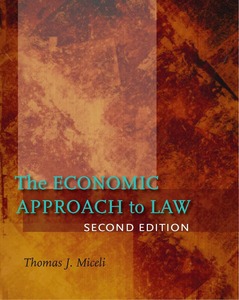Chapter 2
An Economic Model of Tort Law
Key Points
• Tort law is concerned with accidental injuries. Its purposes are twofold: to compensate victims and to deter unreasonably dangerous behavior. The economic theory of tort law emphasizes deterrence.
• Tort law is a private remedy that must be initiated by the victim. To recover damages, the victim must prove that he or she sustained damages and that the injurer caused those damages. Once the victim proves causation, the court applies the relevant liability rule.
• A strict liability rule holds the defendant liable for the victim’s damages once the victim proves causation. A negligence rule requires the victim to further prove that the defendant was at fault—that is, that he or she failed to take reasonable care to avoid the accident.
• The economic theory of tort law is based on the idea that liability for accidental injuries should be assigned so as to minimize the expected costs of accidents, including the harm suffered by victims, the cost of precautions by injurers and victims, and the litigation costs of assigning liability.
• The model of precaution determines the level of precaution by injurers and victims that minimizes the sum of the costs of precaution and expected damages. While explicitly a model of accidents, it will be seen that the model of precaution provides a unifying theoretical framework for the economic approach to law.
• In the model where only injurers can take care (the unilateral care model), both strict liability and negligence induce the injurer to take efficient care. In the case of negligence, this requires that the due standard of care be set equal to the injurer’s optimal (cost-minimizing) care level.
• In the model where both injurers and victims take care (the bilateral care model), only negligence achieves efficient care by both parties. It does this by setting a due standard for the injurer to avoid liability, and imposing the actual damages on the victim.
• The Hand Rule provides a legal standard for determining when an injurer (or victim) is negligent. The marginal version of the Hand Rule specifies a standard for care that coincides with the efficient level of care.
• Several versions of the negligence rule achieve the efficient outcome in bilateral care accidents, provided that the due care standard (or standards) is properly set.
• Sequential care accidents (accidents in which the injurer and victim move in sequence) create more difficult incentive problems, especially with regard to the incentives of the party moving second in the presence of observed negligence by the party that moved first. The doctrine of last clear chance responds to this problem by imposing a duty to take care on the second mover (whether the injurer or the victim), regardless of the first mover’s behavior.
• Comparative negligence apportions liability according to relative fault. Thus, many see it as fairer than all-or-nothing liability rules. Comparative negligence achieves efficient bilateral incentives as long as it allows injurers to avoid liability by meeting the due standard of care.
• Tort law contains two notions of causation: cause-in-fact, which says that an injurer caused an accident if the accident would not have occurred “but for” the injurer’s actions; and proximate cause, which says that the connection between the injurer’s action and the resulting accident must have been foreseeable to a reasonable person.
• In addition to choosing precaution, injurers and victims also choose how intensively or frequently to engage in a risky activity. This is referred to as their activity level. None of the standard negligence rules simultaneously provides incentives for efficient care and activity by both injurers and victims.
• Punitive damages are damages assessed on top of compensatory damages as a way of punishing an injurer for actions seen as intentional or reckless. The economic theory of punitive damages says that they are intended to compensate for imperfect detection of an injurer’s negligence.
• Incentives for efficient care under the various liability rules are diluted by several factors, including insufficient wealth to pay damages (the judgment-proof problem), liability insurance, costly litigation, and legal error.
• A statute of limitation for tort claims balances the reduced incentives for injurer care against the cost of litigating liability claims.
• Economists have developed several methods for calculating the dollar losses suffered by victims of an accident. None is perfect, however, owing to the difficulty of assigning a dollar value to personal injuries or non-market goods.
